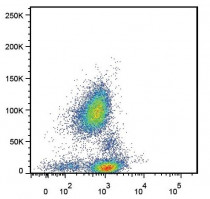ARG62745
anti-CD162 / PSGL1 antibody [TC2]
anti-CD162 / PSGL1 antibody [TC2] for Flow cytometry and Human
Cell Biology and Cellular Response antibody; Immune System antibody
Overview
| Product Description | Mouse Monoclonal antibody [TC2] recognizes CD162 / PSGL1 |
|---|---|
| Tested Reactivity | Hu |
| Tested Application | FACS |
| Specificity | The clone TC2 reacts with CD162, a 220 kDa type I integral membrane protein expressed as disulfide-linked homodimer (sialomucin family). CD162 is present on the most peripheral blood T lymphocytes, monocytes, granulocytes; it is also expressed on a subpopulation of B lymphocytes and CD34+ bone marrow cells. |
| Host | Mouse |
| Clonality | Monoclonal |
| Clone | TC2 |
| Isotype | IgG1 |
| Target Name | CD162 / PSGL1 |
| Antigen Species | Human |
| Immunogen | Human thymocytes |
| Conjugation | Un-conjugated |
| Alternate Names | Selectin P ligand; PSGL1; P-selectin glycoprotein ligand 1; PSGL-1; CD162; CLA; CD antigen CD162 |
Application Instructions
| Application Suggestion |
|
||||
|---|---|---|---|---|---|
| Application Note | * The dilutions indicate recommended starting dilutions and the optimal dilutions or concentrations should be determined by the scientist. | ||||
| Positive Control | FACS: Human peripheral blood. |
Properties
| Form | Liquid |
|---|---|
| Purification | Purified from ascites by protein-A affinity chromatography. |
| Purity | > 95% (by SDS-PAGE) |
| Buffer | PBS (pH 7.4) and 15 mM Sodium azide |
| Preservative | 15 mM Sodium azide |
| Concentration | 1 mg/ml |
| Storage Instruction | For continuous use, store undiluted antibody at 2-8°C for up to a week. For long-term storage, aliquot and store at -20°C or below. Storage in frost free freezers is not recommended. Avoid repeated freeze/thaw cycles. Suggest spin the vial prior to opening. The antibody solution should be gently mixed before use. |
| Note | For laboratory research only, not for drug, diagnostic or other use. |
Bioinformation
| Database Links | |
|---|---|
| Gene Symbol | SELPLG |
| Gene Full Name | selectin P ligand |
| Background | CD162 (P-selectin glycoprotein ligand-1, PSGL-1) is a sialomucin constitutively expressed as a disulfide-linked homodimer of two 120 kDa subunits on the surface of circulating leukocytes. CD162 serves as a ligand for P- E- and L-selectin, with the highest affinity for P-selectin. It is thus involved in leukocyte rolling at the endothelial surfaces, prerequisite for firm leukocyte adhesion and subsequent transendothelial migration. CD162 also mediates leukocyte-platelet adhesion and interleukocyte contacts. Whereas serving as an adhession molecule on mature leukocytes, CD162 is a potent negative regulator of human hematopoietic progenitors. |
| Function | A SLe(x)-type proteoglycan, which through high affinity, calcium-dependent interactions with E-, P- and L-selectins, mediates rapid rolling of leukocytes over vascular surfaces during the initial steps in inflammation. Critical for the initial leukocyte capture. [UniProt] |
| Research Area | Cell Biology and Cellular Response antibody; Immune System antibody |
| Calculated MW | 43 kDa |
| PTM | Displays complex, core-2, sialylated and fucosylated O-linked oligosaccharides, at least some of which appear to contain poly-N-acetyllactosamine with varying degrees of substitution. Mainly disialylated or neutral forms of the core-2 tetrasaccharide, Galbeta1-->4GlcNAcbeta1-->6(Galbeta1-->3)GalNAcOH. The GlcN:GalN ratio is approximately 2:1 and the Man:Fuc ratio 3:5. Contains about 14% fucose with alpha-1,3 linkage present in two forms: One species is a disialylated, monofucosylated glycan, and the other, a monosialylated, trifucosylated glycan with a polylactosamine backbone. The fucosylated forms carry the Lewis antigen and are important for interaction with selectins and for functioning in leukocyte rolling. The modification containing the sialyl Lewis X glycan is on Thr-57. No sulfated O-glycans. Some N-glycosylation. Sulfation, in conjunction with the SLe(x)-containing glycan, is necessary for P- and L-selectin binding. High affinity P-selectin binding has a preferred requirement for the isomer sulfated on both Tyr-48 and Tyr-51, whereas L-selectin binding requires predominantly sulfation on Tyr-51 with sulfation on Tyr-48 playing only a minor role. These sulfations play an important role in L- and P-selectin-mediated neutrophil recruitment, and leukocyte rolling. |
Images (1) Click the Picture to Zoom In






